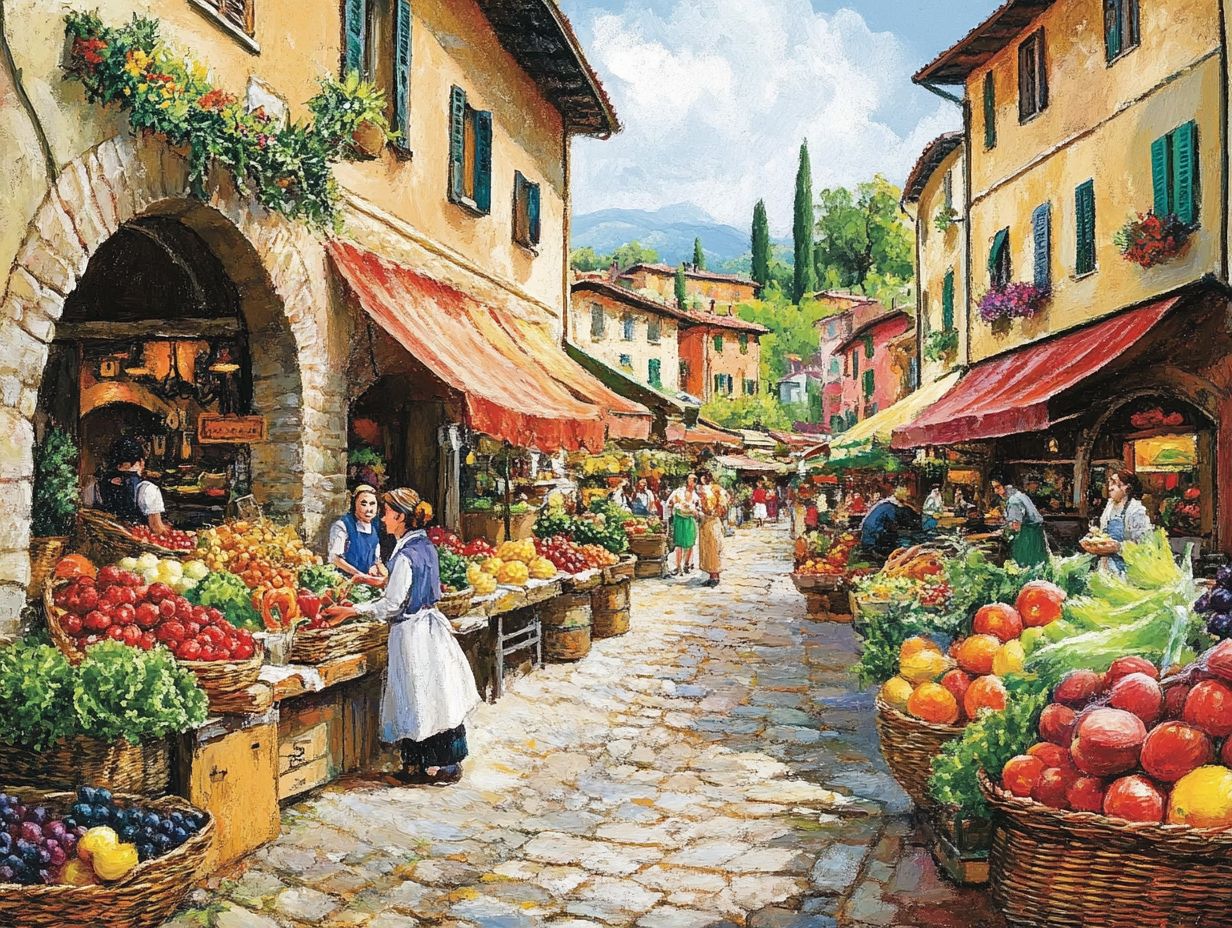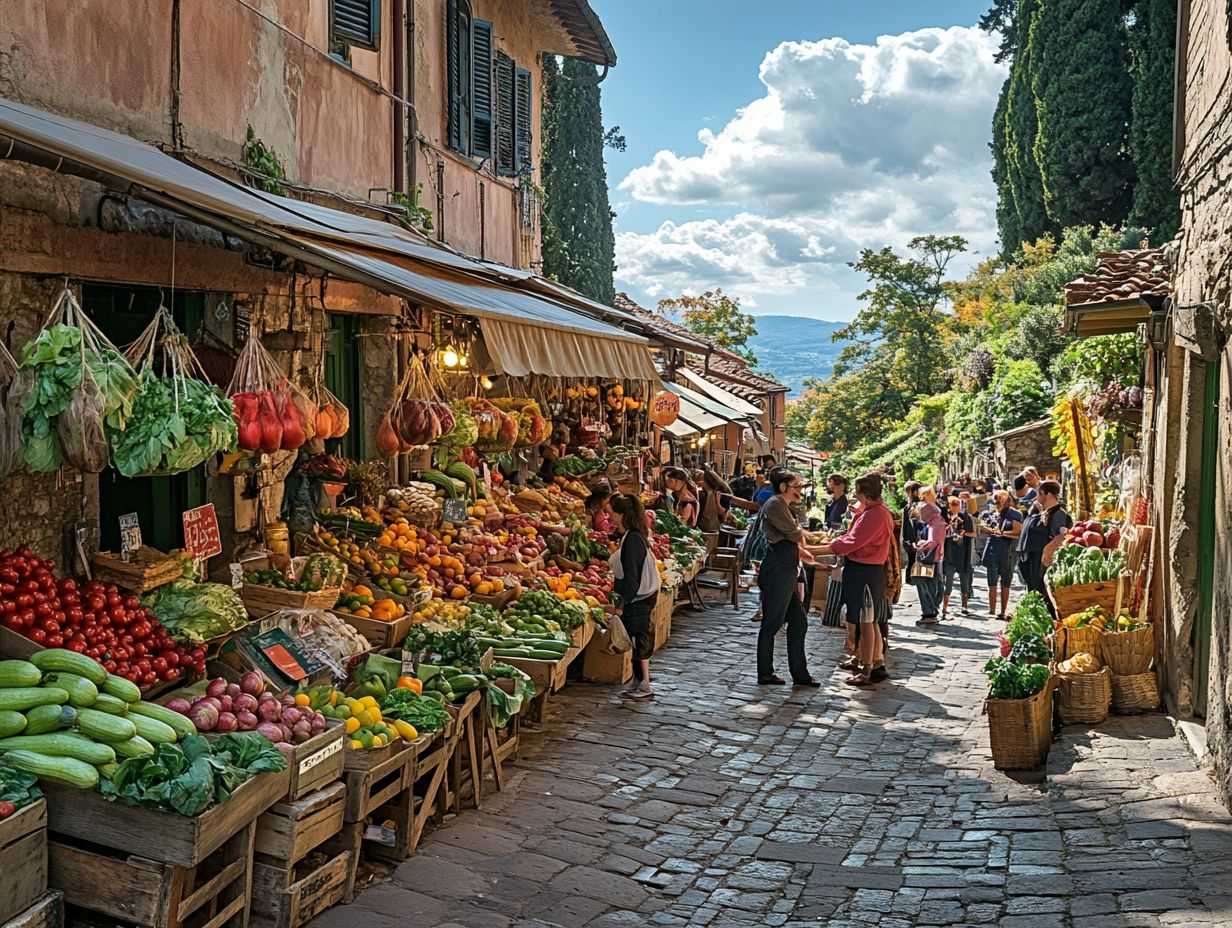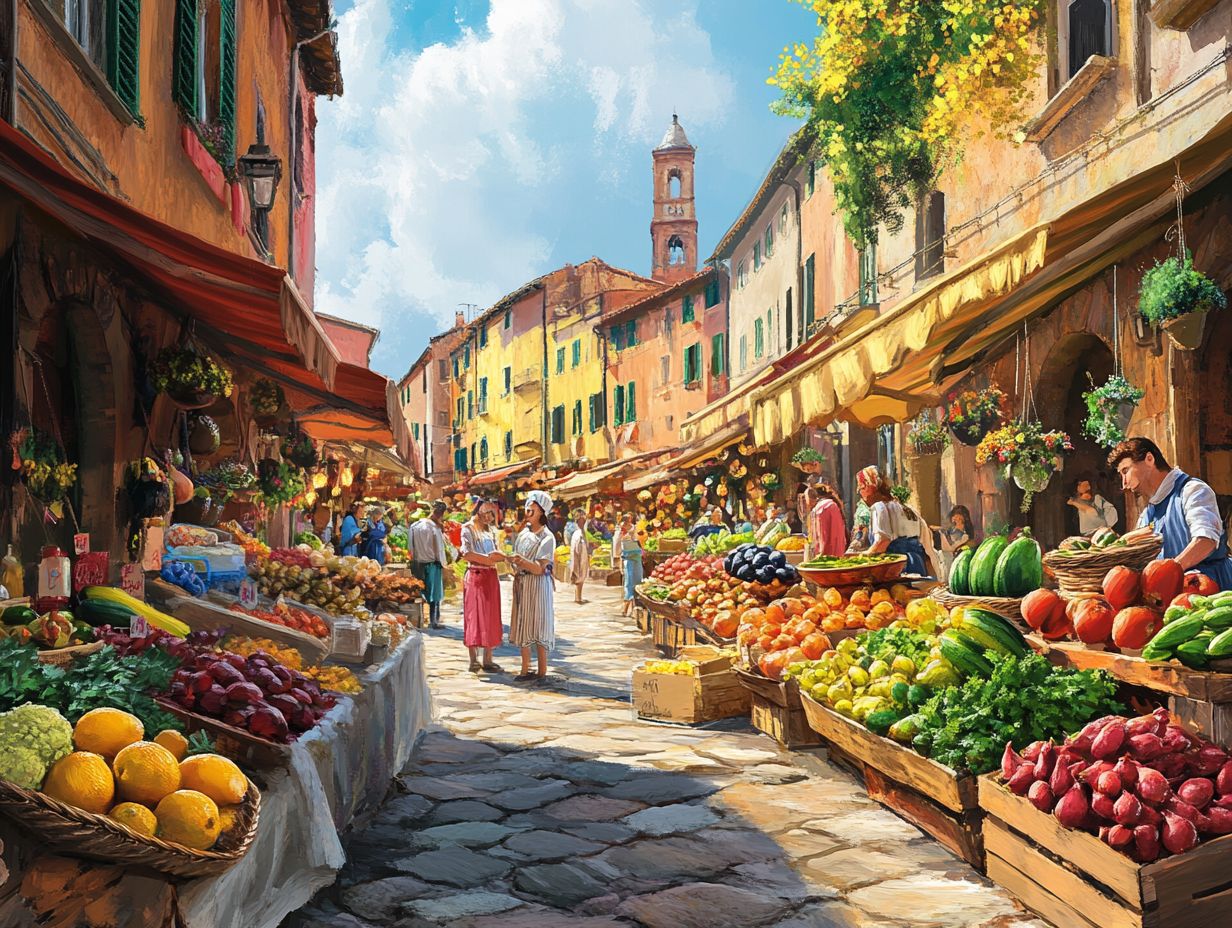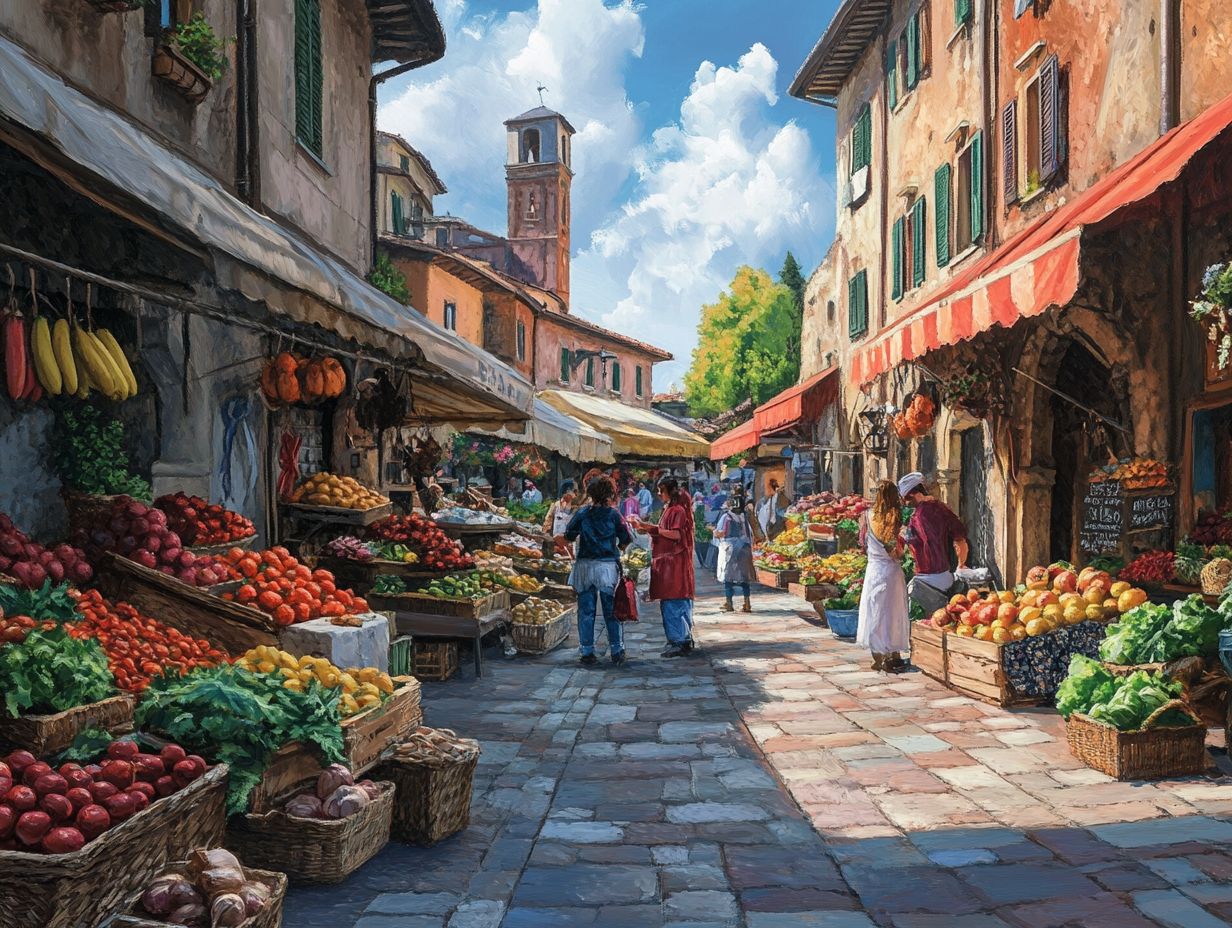Understanding Local Cuisine: Study in Italy
Italian cuisine transcends the stereotypes of pasta and pizza; it weaves together a vibrant tapestry of regional flavors, traditions, and culinary techniques that embody the country’s rich cultural heritage.
As you explore the distinctive ingredients that characterize each region and the time-honored dishes that have withstood the test of time, you’ll uncover the diverse landscape of Italian cooking.
Uncover the essential ingredients, cooking methods, and wine pairings that elevate Italian dishes to new heights. Discover where to seek out the finest culinary experiences in Italy.
Dive in and savor the history and influence of this beloved cuisine!
Contents
- Key Takeaways:
- The History and Influence of Italian Cuisine
- Regional Variations in Italian Cuisine
- Traditional Italian Dishes
- Ingredients in Italian Cuisine
- Preparing and Cooking Italian Cuisine
- Pairing Wine with Italian Dishes
- Exploring Local Markets and Restaurants
- Frequently Asked Questions
- What is local cuisine in Italy?
- What is the importance of studying local cuisine in Italy?
- What are some popular local dishes in Italy?
- What are the main differences between Northern and Southern Italian cuisine?
- How can studying local cuisine in Italy enhance my cooking skills?
- Where can I study local cuisine in Italy?
Key Takeaways:

- Italian cuisine is influenced by its rich history and diverse regional variations, resulting in a wide variety of distinct flavors and ingredients.
- Traditional Italian dishes have their origins rooted in local culture, prepared with key ingredients and cooking techniques passed down through generations.
- To fully experience the flavors of Italian cuisine, dive into local markets and restaurants in different regions and pair your dishes with the perfect wine.
The History and Influence of Italian Cuisine
The history and influence of Italian cuisine are intricately woven into Italy’s rich tapestry of cultural traditions and social customs, showcasing a culinary variety that has evolved over centuries. From ancient Roman gastronomy to the regional specialties that grace tables today, the evolution of Italian food narrates a compelling tale of farming methods, trade routes, and the merging of local and global influences.
This narrative highlights the distinct flavors and staple foods that define Italy’s cultural identity, illustrating how culinary skills and food practices have shaped the nation’s food culture throughout the ages.
Regional Variations in Italian Cuisine
Italian cuisine captivates with its rich regional variations, each area of Italy contributing distinct flavors and traditional dishes to the culinary landscape.
Imagine savoring the hearty pasta creations of Emilia-Romagna or indulging in the exquisite seafood specialties found along the coast. These influences beautifully highlight Italy’s agricultural heritage and vibrant local markets.
Distinct Flavors and Ingredients in Different Regions
Distinct flavors and ingredients define the various regions of Italy. Picture yourself savoring the robust flavors of Tuscan bread soup or experiencing the delicate tastes of Piedmont s exquisite wine and cheese pairings. Each region proudly showcases its local delicacies, a testament to its unique agricultural practices.
In the coastal regions like Liguria, indulge in fresh seafood, perfectly complemented by fragrant basil in traditional pesto. The vibrant markets of Sicily celebrate an abundance of citrus, olives, and the renowned caponata.
Seasonal ingredients are vital in this culinary landscape. In Emilia-Romagna, the harvest of rich Parmigiano-Reggiano cheese and balsamic vinegar aligns perfectly with the region s culinary traditions.
This diverse array of flavors narrates a captivating story of land and heritage, with each dish reflecting the essence of its origin.
Traditional Italian Dishes
Traditional Italian dishes are revered worldwide, each carrying its own historical recipes and cultural importance. These meals often highlight staple ingredients like pasta and cheese, showcasing the remarkable culinary skills of Italian chefs.
They reflect the country’s rich food heritage, emphasizing the aesthetics and flavors that epitomize Italian gastronomy.
Ready to taste Italy’s treasures? Start your culinary adventure today!
Popular Dishes and Their Origins

Popular dishes like Cacio e Pepe and other pasta creations have fascinating origins rooted in Italy’s rich culinary tapestry. Each dish embodies the essence of its region whether it’s the creamy sauces of the north or the simpler, rustic flavors of the south.
The history of these meals shows the ingredients and the cultural exchanges that shaped them. For example, the abundant use of cheese in northern recipes stems from dairy farming traditions established in the Alps. In contrast, southern cuisine relies heavily on vegetables and legumes, highlighting the Mediterranean climate and its agricultural practices.
Various cooking techniques, like slow-simmering sauces and fresh pasta preparation, have been passed down through generations. These showcase the perfect blend of practicality and artistry that defines Italian culinary heritage.
Ingredients in Italian Cuisine
Ingredients are essential to Italian cuisine, with staples such as extra-virgin olive oil, fresh vegetables, and seasonal produce serving as the foundation of traditional meals. These elements enhance the flavors and embody the Mediterranean diet s commitment to fresh and sustainable ingredients.
Key Ingredients and Their Uses
Key ingredients in Italian cuisine include essentials like extra-virgin olive oil, cheese, wine, and pasta. Each plays a vital role in enhancing culinary techniques and enriching traditional cooking methods.
Imagine drizzling rich, extra-virgin olive oil over your bruschetta or using it as a base for salad dressings, infusing a fruity note. Cheese varieties such as Parmigiano-Reggiano are essential for grating over dishes like risotto, adding depth and savory umami.
In dishes like Osso Buco, wine serves as both a marinade and simmering liquid, allowing flavors to meld harmoniously. Pasta absorbs sauces beautifully, as seen in spaghetti alla carbonara, where simple ingredients unite to create intricate flavors.
Preparing and Cooking Italian Cuisine
Preparing and cooking Italian cuisine demands a good knowledge of diverse techniques and methods that guarantee authenticity in flavor and presentation. From crafting fresh pasta to mastering traditional sauces, these skills embody the essence of Italian cooking and its rich gastronomic traditions.
Techniques and Methods for Authentic Italian Cooking
Embracing methods for authentic Italian cooking means diving into practices passed down through generations. Picture yourself mastering slow-cooking techniques and precise ingredient pairings to create dishes that echo Italy’s rich cultural heritage.
The use of fresh, seasonal ingredients highlights local produce, elevating flavors to new heights. Imagine the satisfaction of mastering pasta al dente meaning “to the tooth,” or firm or perfecting the art of risotto each showcasing your dedication to culinary craft.
Understanding regional variations enhances your authenticity in the kitchen. Southern Italy often embraces robust tomato-based sauces, while northern regions favor the indulgence of cream and butter.
Incorporating time-honored practices like hand-rolling pasta or baking in a wood-fired oven adds an irreplaceable touch to your dishes. This not only brings traditional meals to life but also maintains a profound connection to Italy s rich culinary past.
Pairing Wine with Italian Dishes

Pairing wine with Italian dishes is an art that enhances your dining experience, reflecting the rich culinary traditions of Italy’s diverse regions.
Understanding how to pair food with wine can change your meals, allowing the unique flavors of each to harmonize and shine together.
Tips for Choosing the Perfect Wine Pairing
Choosing the perfect wine pairing can elevate your culinary experiences, especially with Italian cuisine. Key considerations include the flavors of your dish, the weight of the wine, and regional pairings to achieve harmony.
By knowing the essential characteristics of both your food and wine, you can create a delightful synergy. For example, richer sauces often crave full-bodied reds like Chianti or Barolo.
On the other hand, lighter pasta dishes may pair nicely with a crisp white like Pinot Grigio.
Considering the acidity of tomatoes in dishes like marinara sauce will guide you toward wines that mirror that brightness. Exploring regional traditions will help you find wines that enhance your dishes, creating an authentic tasting journey.
Exploring Local Markets and Restaurants
Discovering local markets and restaurants is a must for any foodie! It offers captivating insights into the rich food culture and culinary expertise shaping Italy s gastronomic landscape.
These venues provide access to fresh, regional ingredients and dining experiences that reflect the unique customs of Italy, allowing you to savor the essence of Italian life.
Where to Find the Best Italian Cuisine in Italy
Finding the best Italian cuisine in Italy means embarking on a delightful journey through local markets and restaurants, each showcasing regional dishes. From bustling food markets to charming family-run trattorias, these spots embody Italy’s vibrant food culture.
Take Bologna, for example, where the rich, savory flavors of homemade pasta especially the iconic tagliatelle al rag shine brightly, reflecting the region’s pride in its traditional recipes.
In Naples, you can’t miss the chance to taste the world-famous Neapolitan pizza, where the crispy crust, fresh tomatoes, and creamy mozzarella create the essence of authentic Italian fare.
Further north in Turin, delightful agnolotti awaits, paired with irresistible chocolate specialties. Meanwhile, the coastal towns of Amalfi feature fresh seafood dishes, often artfully paired with local limoncello.
These culinary experiences not only tantalize your taste buds but also immerse you in the local culture, making every meal an unforgettable adventure.
Frequently Asked Questions
What is local cuisine in Italy?

Local cuisine in Italy consists of traditional dishes unique to each region. Each area has its own ingredients, cooking techniques, and flavors that shape its culinary identity.
What is the importance of studying local cuisine in Italy?
Studying local cuisine in Italy helps you understand the country’s culture, history, and traditions. It allows you to explore the diverse flavors and ingredients that define Italian food.
What are some popular local dishes in Italy?
Some popular local dishes include pizza, pasta, risotto, arancini, and gelato. Each region also boasts unique specialties, such as lasagna from Emilia-Romagna, cannoli from Sicily, and polenta from Veneto.
What are the main differences between Northern and Southern Italian cuisine?
Northern Italian cuisine features rich and creamy dishes. These are influenced by neighboring countries like France and Austria.
In contrast, Southern Italian cuisine bursts with bold, simple flavors. It focuses heavily on fresh seafood and vegetables, making every bite a delight.
How can studying local cuisine in Italy enhance my cooking skills?
Studying local cuisine in Italy introduces you to new ingredients and techniques. You can learn from experienced chefs and immerse yourself in the vibrant food culture.
Where can I study local cuisine in Italy?
Italy offers numerous culinary schools focused on local cuisine. Popular choices include the Culinary Institute of Bologna, Apicius International School of Hospitality in Florence, and ALMA – The International School of Italian Cuisine in Parma.






